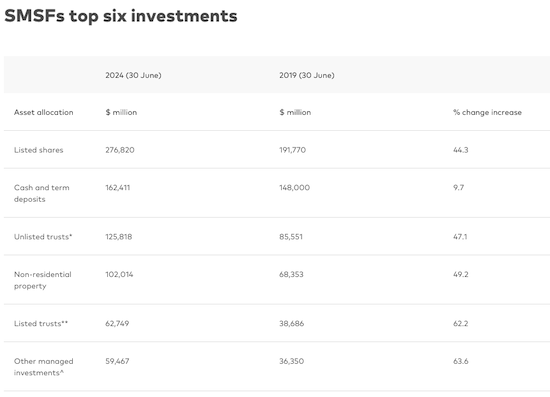The biggest assets growth areas for SMSFs
What five years’ worth of SMSF asset allocation data reveals.

.
The Australian Tax Office (ATO) releases quarterly data showing where self-managed superannuation funds (SMSFs) are parking the retirement savings that they have invested within the super system.
The data for the three months ended June 30, 2024, which was released in September, shows there were 625,609 SMSFs managing $990.4 billion of assets on behalf of around 1.15 million fund members.
The ATO’s data also shows, by dollar value invested, the broad asset categories where SMSFs are allocating their capital. The estimates are based on data provided by SMSFs reporting their financial position as at 30 June of the relevant financial year.
On a quarter-by-quarter basis the total amounts in each category don’t change all that much. But it’s worth tracking how SMSF investment trends have changed over a longer period of time.
Since 30 June, 2019, when total SMSF assets were $714.5 billion, the amount invested into the "DIY" super segment has risen by 38.6%.
The broad increases in the totals reflect a combination of investment growth and increased SMSF inflows into certain categories.
How SMSF investments have changed over five years
The ATO breaks down SMSF investments into 20 asset types. For the purposes of this article we’ve focused on six core asset categories where SMSFs in aggregate are holding the most assets.
Collectively, they accounted for $789.3 billion of investments at 30 June this year – about 80% of total SMSF assets.
At 30 June, 2019 (five years ago) these same categories held $568.7 billion of the total SMSF assets at that time of $714.6 billion – about 79% of total SMSF assets.
So, where have the biggest investment asset allocation changes occurred over the last five financial years?
The broad increases in the totals reflect a combination of investment growth and increased SMSF inflows into certain categories.
Yet, there are some clear trends and others that can be gleaned from SMSFs research.
For example, although cash and term deposits remains the second-largest asset category held by SMSFs, as a percentage of total SMSF assets it has only increased slightly over the last five years.
Increased allocations to ETFs and managed investments
The two biggest increases in terms of percentage growth have been listed trusts, which include exchange traded funds (ETFs), and “other managed investments”.
The 62.2% increase in the value of listed trusts investments from $38.6 billion in June 2019 to $62.7 billion by June 2024 reflects investment markets’ growth and the significant pivot by SMSF investors into ASX-listed ETFs over the past five years.
According to the 2024 Vanguard/Investment Trends SMSF Report, released in May, around 43% of SMSFs (265,000 funds) are now using ETF products.
The growth in allocation to ETFs is the outcome of both increased adoption (57%, up from 45% in 2023) and increased average amount allocated ($250,000, up from $180,000 the year before).
Meanwhile, there has been a 63.6% increase in the value of what the ATO terms as other managed investments from $36.3 billion in June 2019 to $59.4 billion by June 2019.
The ATO states this asset category includes investments where an external investment manager has been appointed by an SMSF trustee to manage a private investment.
This is separate from the ATO category “Unlisted trusts”, which largely incorporates index-tracking and active funds. Over the last five years the amount invested in the unlisted trusts category rose by 47.1% from $85.5 billion to $125.8 billion, making it the third-largest investment category.
Source: Australian Tax Office
Notes: *Unlisted trusts incorporate managed investment funds. **Listed trusts incorporate exchange traded funds (ETFs). ^Other managed investments incorporate investments where a SMSF trustee appoints an external manager to manage a private investment.
Non-residential (commercial) property is the fourth-largest SMSF investment category by value. Between 30 June, 2019 and 30 June, 2024 the amount invested into this category rose by 49.2% from $68.3 billion to $102 billion.
It’s important to keep in mind that many SMSFs are used by business owners to hold their commercial property assets.
The 2024 Vanguard/Investment Trends SMSF Report found that, as trustees get older, they tend to increase their allocations to listed shares and cash and decrease their investments in investment and commercial property.
A growing proportion of SMSFs are focusing on building a sustainable income stream.
Important Information
Vanguard Investments Australia Ltd (ABN 72 072 881 086 / AFS Licence 227263) (“Vanguard”) is the issuer of the Vanguard® Australian ETFs. Vanguard ETFs will only be issued to Authorised Participants. That is, persons who have entered into an Authorised Participant Agreement with Vanguard (“Eligible Investors”). Retail investors can transact in Vanguard ETFs through Vanguard Personal Investor, a stockbroker or financial adviser on the secondary market.
We have not taken your objectives, financial situation or needs into account when preparing this publication so it may not be applicable to the particular situation you are considering. You should consider your objectives, financial situation or needs, and the disclosure documents for Vanguard’s products before making any investment decision. Before you make any financial decision regarding Vanguard’s products you should seek professional advice from a suitably qualified adviser. . The Target Market Determination (TMD) for Vanguard’s ETFs include a description of who the ETF is appropriate for. You can access our IDPS Guide, PDSs Prospectus and TMD at vanguard.com.au or by calling 1300 655 101.
© 2024 Vanguard Investments Australia Ltd. All rights reserved.
Tony Kaye
30 OCT 2024
vanguard.com.au




